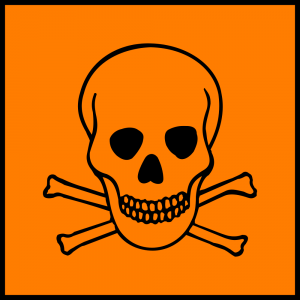Towards the end of the last millennium, I spent a lot of time befriending arsenic. The last two years of my PhD involved measuring how much iodine had fallen off a chemical used as a wood preservative day-in, day-out, and arsenic trioxide was the most exciting component of an otherwise excruciatingly dull test for iodide ions.
My little bottles of arsenic warned me to beware of pirates…
…for there were enough pirates in each 10 gram bottle to kill me ten times over. I apparently managed to handle the stuff safely, as – at least so far – I’m not dead even one time over.
Arsenic became so popular as a detergent for getting stubborn relatives out of the family that by the late nineteenth century people started referring to it as “inheritance powder”.
A (not very) cheap and (exceptionally) nasty way to work out how poisonous something like arsenic is, is to take ten cages containing ten rats each, and give each cageful of rats an increasingly large dose of the poison in question. The individual rats will differ in how easy they are to kill with the poison, but the rats in the cages that get very small doses will probably all survive, and the rats in the cages that get very large doses will probably all die. Somewhere in the middle you’ll probably find a cage containing 5 corpses and 5 survivors. The dose of poison that kills half the rats in a cage is called the “lethal dose, 50%” or LD50. The LD50 for arsenic trioxide is about 10 milligrams for rats.
Humans are a lot heavier than rats: I’m 60-odd kilograms on a good day, a rat only half a kilo or so. Bigger animals are can survive higher doses of poisons because the poison ends up diluted into their larger bodies. So LD50 values are usually scaled for the size of their victim. If 10 mg kills a 0.5 kg rat, the LD50 is 20 mg kg−1. By maths and educated guesswork about the relative susceptibilities of rats and humans to arsenic (apparently the definitive experiment is unethical), the LD50 for a human (this human, specifically) is just over 1 gram.
Arsenic is pretty poisonous, but some other poisons beat it hands-down. Botulinum toxin, the active ingredient in Botox injections, has an LD50 of 1 ng kg−1 which is about 10 million times more lethal. But, as even 16th century proto-doctors noted, it’s the dose that makes the poison. Everything is poisonous in sufficient quantity, even things as seemingly innocuous as water.
Even the most child-proofed kitchen could kill you three times over. You just need to put in a little effort:
The LD50 of water is about 100 mL kg−1, at least in rats. For a runt like me, that means around 6 L of water drunk over a short period of time would be lethal, mostly by diluting the salts in my blood and tissue fluid to the point where water would flood into my cells, making them swell and pop.The opposite effect could be achieved by eating too much common table salt, which would suck water out of my cells, causing them to shrivel. With an LD50 is about 3 g kg−1, pretty much every kitchen in the land has a pot of salt in it containing at least one lethal dose:
It’s pretty difficult to eat even a teaspoon of neat salt without puking, so I shouldn’t worry about anyone trying to get their inheritance early by force-feeding you table salt rather than good old arsenic, but it might just be possible to get someone to eat the necessary dose of sugar. With an LD50 of 30 g kg−1, that would mean eating 2 kg of the stuff, but it’s certainly a sweeter way to go than many.

![Water LD50 [CC-BY-SA-3.0 Steve Cook]](http://www.polypompholyx.com/wp-content/uploads/2015/08/water_ld50-230x300.jpg)
![Salt LD50 [CC-BY-SA-3.0 Steve Cook]](http://www.polypompholyx.com/wp-content/uploads/2015/09/salt_ld50-300x283.jpg)
![Sucrose LD50 [CC-BY-SA-3.0 Steve Cook]](http://www.polypompholyx.com/wp-content/uploads/2015/09/sucrose_ld50-279x300.jpg)